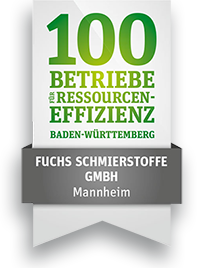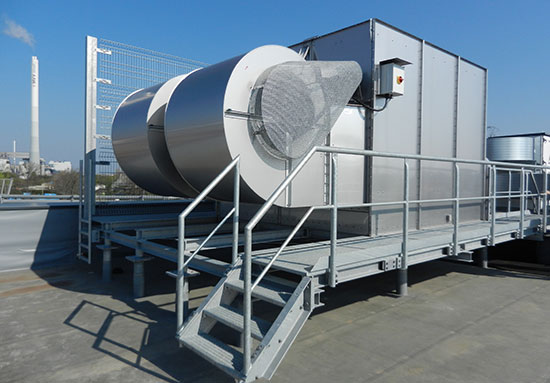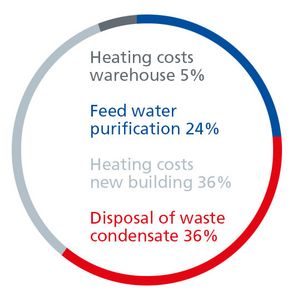Construction of a new testing facility taking existing waste streams into account
A contribution to sustainability
Background and objectives
A new building was to be built at the Mannheim site of FUCHS LUBRICANTS GERMANY with 1,200 m² of usable area for 10 to 15 additional test bays for the mechanical testing of lubricants with particular attention given to the future sustainable operation of the building. Measures such as building insulation, LED lighting and ventilation systems with maximum heat recovery were included in the planning.
To cool the test bays, which have peak outputs of up to 1.5 MW, the most energy-efficient cooling and cold water network possible was planned, with regulated energy-efficient pumps and two temperature levels with cooling tower and chillers. The original plan was to heat the building by means of a district steam network, as is customary on site. During the planning phase, however, it became apparent that large quantities of hot condensate were produced in the neighbouring production facility, which had remained unused to date and only been cooled and discharged as wastewater. This condensate is being generated during the use of saturated steam as process heat for production and on-site buildings.
However, the condensate has two properties relevant to the new testing facility: owing to its high temperature, it still holds a large amount of usable energy and as a condensate it is fully desalinated, making it ideal for operating the cooling tower and adiabatic air cooling.
Award for resource efficiency

Challenge
The hot condensate produced in the adjacent section of the plant has a temperature of 90 to 95 °C, but it accumulates very irregularly due to changing production conditions and seasonal fluctuations. Peak values of up to 10 m³/h must be taken into account, as well as a significantly reduced amount of condensate on non-production weekends. At the other end, the heating energy and cooling tower feed water requirements of the new testing building are also subject to fluctuations due to outside temperature and test bay load.
Idea
Measures to sustainably improve the energy footprint of a technical building can be implemented most efficiently if they are already taken into account in the planning phase. For this reason, the use of the waste condensate was explicitly included in the construction project in an additional planning round. The aim was to extract the maximum heat content from the hot condensate and at the same time to use as much as possible of the cooled condensate as feed water. As part of the overall planning of the plant section additional consumers of heat at a lower temperature level were to be identified as well as guaranteeing reliable operation in summer.



Implementation
The hot condensate is pumped from the existing pipeline into two collecting tanks each with a volume of 30 m³. From there it is fed to the testing building where it supplies the ventilation systems as well as the radiators and ceiling-mounted air heaters via heat exchangers. In the process, the condensate is cooled to a minimum of 50 °C and then some of it is used as warm condensate to heat a small adjoining building and to keep the cooling tower and an adjacent 900 m² storage building frost-free.
After this second thermal application, the condensate, now at approx. 30 to 40 °C, flows through a chiller into a cold condensate tank with a volume of 5 m³. The fully desalinated water is drawn from the cold condensate tank to feed into the cooling tower as required (max. 4 m³/h). The cold condensate is also used to operate an adiabatic exhaust air cooling system, which uses cross-flow heat exchangers to ensure that the supply air for the testing building is pre-cooled in summer thus significantly reducing its need for cooling. Excess condensate is discharged as wastewater.
One of the two hot condensate tanks can also serve as a warm condensate storage tank to cope with seasonal fluctuations in cold and hot condensate requirements. The hot condensate is also used thermally and as material to humidify part of a building where the humidity must be controlled for process reasons. The entire plant is monitored and controlled by a modern instrumentation, control and automation system (ICA), which also allows detailed analyses of material and energy flows. This ensures the efficiency of the system is maintained under varying boundary conditions (weather conditions, cooling requirements of the test bays, generation of hot condensate, etc.).

Savings
The thermal utilisation of the hot condensate significantly reduces the annual demand for district steam used to heat the testing building and the adjoining buildings by more than 40% and the electrically-run frost protection of one warehouse building can be completely eliminated. In total, approx. 130 MWh are saved annually, which corresponds to a CO2 equivalent of around 18 t/year.
The use as feed water for the cooling tower and adiabatic air cooling also pays off. The (cooled) condensate is fully desalinated water, so it is ideally suited for evaporation in these plants in order to use the enthalpy for cooling. This decreases both the need for purified water by around 1,000 m³/year and the need for sludge removal due to reduced salt enrichment. The costs formerly entailed in wastewater disposal and cooling of the waste condensate are also largely eliminated.
Learning objective
The new testing building was put into operation in February 2017, the technical building services, to which the use of the waste condensate belongs, are still being tested. In addition, only a few test bays were moved in to begin with, so that only a small portion of the cooling capacity expected in the completed building is required. It is therefore too soon to draw a comparison between expectations and what has been achieved.
It has been demonstrated since October 2016, however, that heating buildings by means of waste condensate and energy recovery via cross-flow heat exchangers actually works, at least in principle. In colder weather in winter 2016-2017, additional heating energy did have to be supplied in the form of district steam. This was also due to the fact that the actual amount of hot condensate that accumulated in the plant fell short of planning expectations. Although this extends the payback period of the concept, it does not alter its fundamental suitability for sustainable resource conservation. In the future, efforts will be made to re-use the condensate in particular areas of other sections of the plant.
